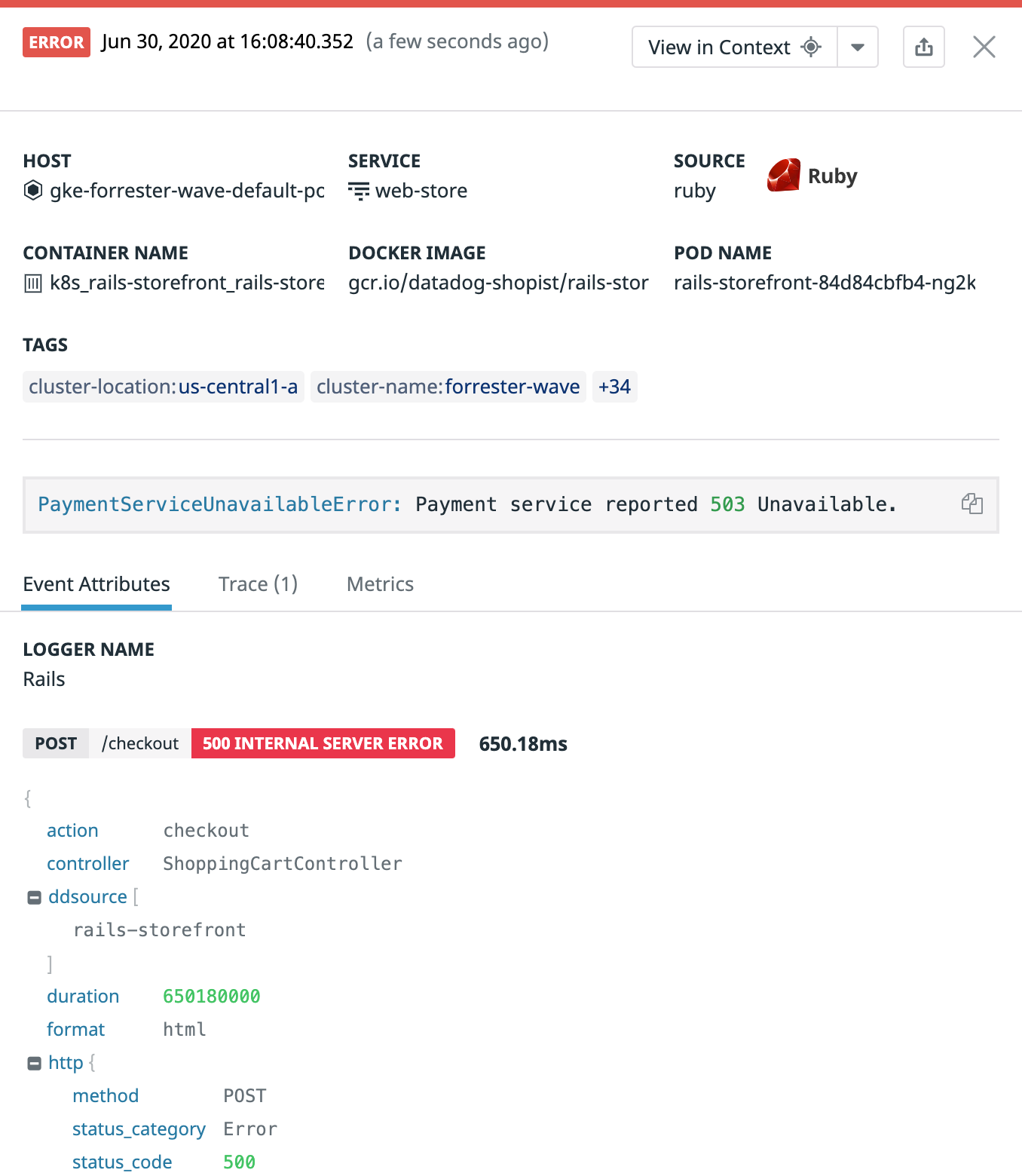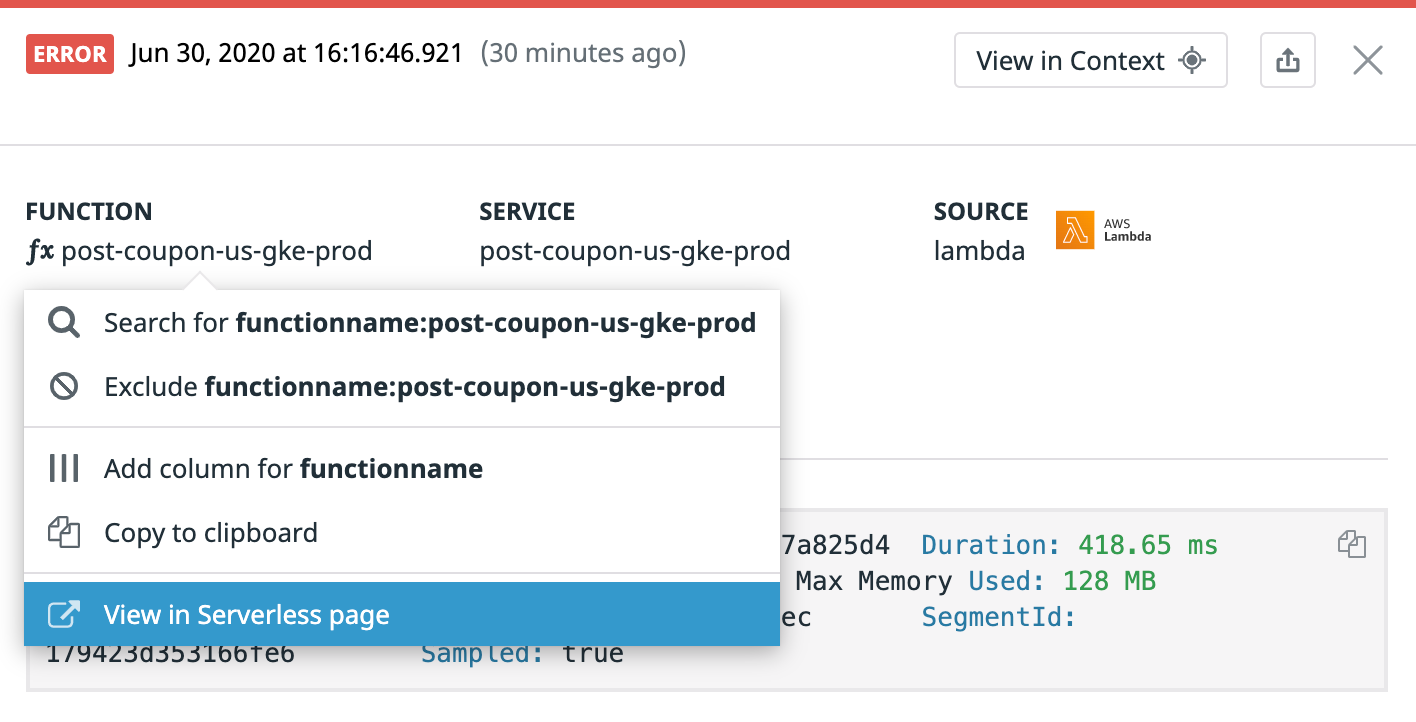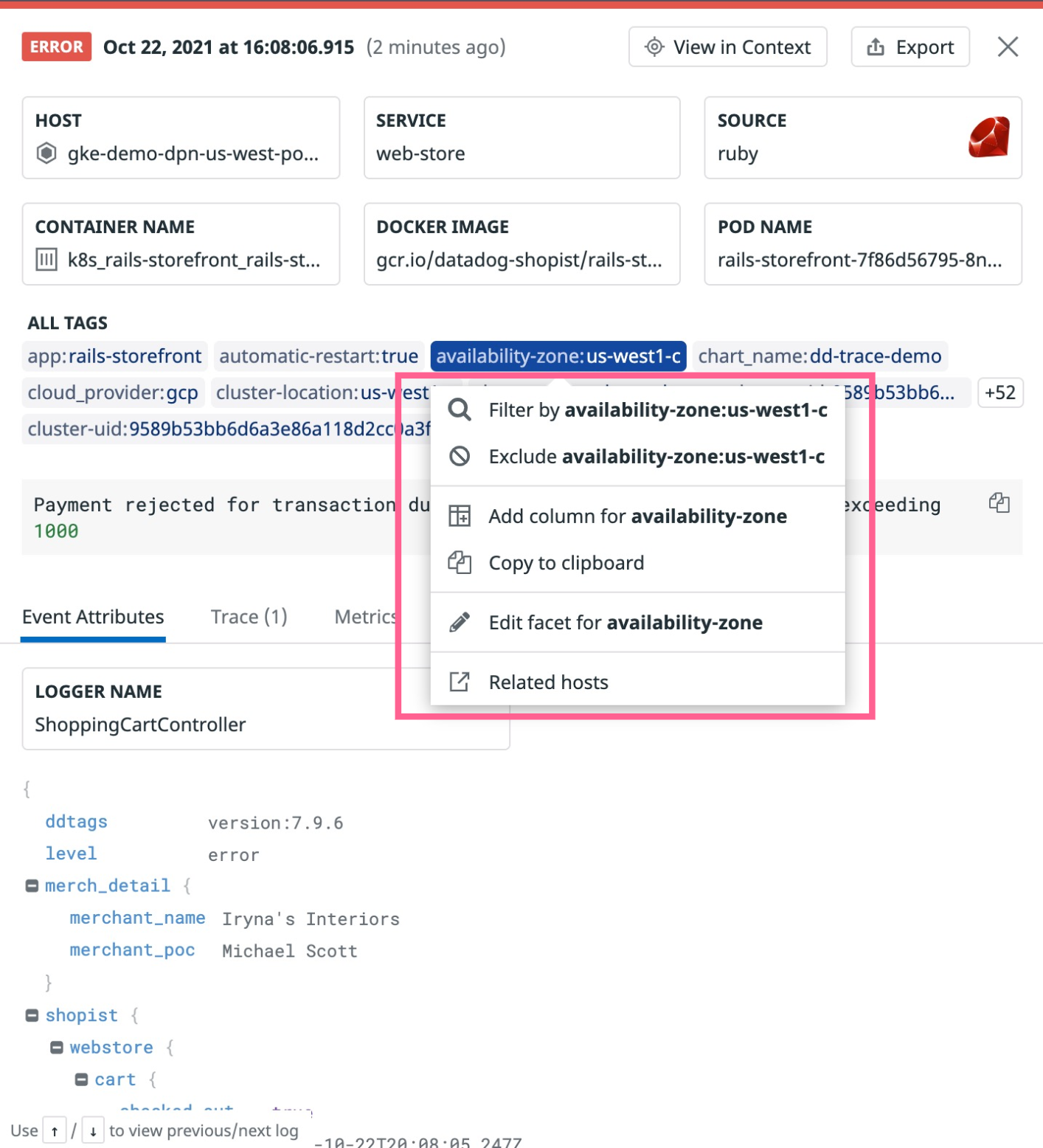- Esenciales
- Empezando
- Datadog
- Sitio web de Datadog
- DevSecOps
- Serverless para Lambda AWS
- Agent
- Integraciones
- Contenedores
- Dashboards
- Monitores
- Logs
- Rastreo de APM
- Generador de perfiles
- Etiquetas (tags)
- API
- Catálogo de servicios
- Session Replay
- Continuous Testing
- Monitorización Synthetic
- Gestión de incidencias
- Monitorización de bases de datos
- Cloud Security Management
- Cloud SIEM
- Application Security Management
- Workflow Automation
- CI Visibility
- Test Visibility
- Intelligent Test Runner
- Análisis de código
- Centro de aprendizaje
- Compatibilidad
- Glosario
- Atributos estándar
- Guías
- Agent
- Uso básico del Agent
- Arquitectura
- IoT
- Plataformas compatibles
- Recopilación de logs
- Configuración
- Configuración remota
- Automatización de flotas
- Actualizar el Agent
- Solucionar problemas
- Detección de nombres de host en contenedores
- Modo de depuración
- Flare del Agent
- Estado del check del Agent
- Problemas de NTP
- Problemas de permisos
- Problemas de integraciones
- Problemas del sitio
- Problemas de Autodiscovery
- Problemas de contenedores de Windows
- Configuración del tiempo de ejecución del Agent
- Consumo elevado de memoria o CPU
- Guías
- Seguridad de datos
- Integraciones
- OpenTelemetry
- Desarrolladores
- Autorización
- DogStatsD
- Checks personalizados
- Integraciones
- Crear una integración basada en el Agent
- Crear una integración API
- Crear un pipeline de logs
- Referencia de activos de integración
- Crear una oferta de mercado
- Crear un cuadro
- Crear un dashboard de integración
- Crear un monitor recomendado
- Crear una regla de detección Cloud SIEM
- OAuth para integraciones
- Instalar la herramienta de desarrollo de integraciones del Agente
- Checks de servicio
- Complementos de IDE
- Comunidad
- Guías
- API
- Aplicación móvil de Datadog
- CoScreen
- Cloudcraft
- En la aplicación
- Dashboards
- Notebooks
- Editor DDSQL
- Hojas
- Monitores y alertas
- Infraestructura
- Métricas
- Watchdog
- Bits AI
- Catálogo de servicios
- Catálogo de APIs
- Error Tracking
- Gestión de servicios
- Objetivos de nivel de servicio (SLOs)
- Gestión de incidentes
- De guardia
- Gestión de eventos
- Gestión de casos
- Workflow Automation
- App Builder
- Infraestructura
- Universal Service Monitoring
- Contenedores
- Serverless
- Monitorización de red
- Coste de la nube
- Rendimiento de las aplicaciones
- APM
- Términos y conceptos de APM
- Instrumentación de aplicación
- Recopilación de métricas de APM
- Configuración de pipelines de trazas
- Correlacionar trazas (traces) y otros datos de telemetría
- Trace Explorer
- Observabilidad del servicio
- Instrumentación dinámica
- Error Tracking
- Seguridad de los datos
- Guías
- Solucionar problemas
- Continuous Profiler
- Database Monitoring
- Gastos generales de integración del Agent
- Arquitecturas de configuración
- Configuración de Postgres
- Configuración de MySQL
- Configuración de SQL Server
- Configuración de Oracle
- Configuración de MongoDB
- Conexión de DBM y trazas
- Datos recopilados
- Explorar hosts de bases de datos
- Explorar métricas de consultas
- Explorar ejemplos de consulta
- Solucionar problemas
- Guías
- Data Streams Monitoring
- Data Jobs Monitoring
- Experiencia digital
- Real User Monitoring
- Monitorización del navegador
- Configuración
- Configuración avanzada
- Datos recopilados
- Monitorización del rendimiento de páginas
- Monitorización de signos vitales de rendimiento
- Monitorización del rendimiento de recursos
- Recopilación de errores del navegador
- Rastrear las acciones de los usuarios
- Señales de frustración
- Error Tracking
- Solucionar problemas
- Monitorización de móviles y TV
- Plataforma
- Session Replay
- Exploración de datos de RUM
- Feature Flag Tracking
- Error Tracking
- Guías
- Seguridad de los datos
- Monitorización del navegador
- Análisis de productos
- Pruebas y monitorización de Synthetics
- Continuous Testing
- Entrega de software
- CI Visibility
- CD Visibility
- Test Visibility
- Configuración
- Tests en contenedores
- Búsqueda y gestión
- Explorador
- Monitores
- Flujos de trabajo de desarrolladores
- Cobertura de código
- Instrumentar tests de navegador con RUM
- Instrumentar tests de Swift con RUM
- Detección temprana de defectos
- Reintentos automáticos de tests
- Correlacionar logs y tests
- Guías
- Solucionar problemas
- Intelligent Test Runner
- Code Analysis
- Quality Gates
- Métricas de DORA
- Seguridad
- Información general de seguridad
- Cloud SIEM
- Cloud Security Management
- Application Security Management
- Observabilidad de la IA
- Log Management
- Observability Pipelines
- Gestión de logs
- Administración
- Gestión de cuentas
- Seguridad de los datos
- Sensitive Data Scanner
- Ayuda
Log Side Panel
This page is not yet available in Spanish. We are working on its translation.
If you have any questions or feedback about our current translation project, feel free to reach out to us!
If you have any questions or feedback about our current translation project, feel free to reach out to us!
Overview
Datadog displays individual logs following this general side panel layout:
- The upper part of the panel displays general context information
- The lower part of the panel displays the actual content of the log
Context refers to the infrastructure and application context which the log has generated. Information is gathered from tags, whether automatically attached (host name, container name, log file name, serverless function name, etc.) or added through custom tags (team in charge, environment, application version, etc.) to the log by the Datadog Agent or Log Forwarder.
Content refers to the log itself. This includes the log message, as well as all structured information extracted and enriched from the logs through Log Pipelines. For logs generated by common components of a technical stack, parsing and enriching comes out-of-the-box.
- For file log collection, make sure you properly set up the source field, which triggers file log collection. See Log Integrations for reference.
- For container log collection, use Autodiscovery.
Some standard fields, for instance error.stack, http.method, or duration, have specific enhanced displays in the Log Panel for better readability. Extract corresponding information from your logs and remap your attributes with standard attribute remappers.
Hub to other data sources
Correlate with infrastructure data
The View in context button updates the search request in order to show you the log lines dated just before and after a selected log, even if they don’t match your filter. This context is different according to the situation, as Datadog uses the Hostname, Service, filename, and container_id attributes, along with tags, in order find the appropriate context for your logs.
Click on the Metrics tab and access underlying infrastructure metrics in a 30 minutes time frame around the log.
Interact with Host in the upper reserved attributes section, the related host dashboard, or Network Analytics page. Interact with Container sections to navigate to the container page scoped with the underlying parameters.
When logs come from a serverless source, the Host Section is replaced with a Serverless section that links to the corresponding serverless page.
Correlate with APM data
Make sure you enable trace injection in logs and follow the Unified Service Tagging best practices to benefit from all the capabilities of Logs and APM correlation.
Click on the Trace tab and see a log in the context of its entire trace, with upstream and downstream services running. Deep dive into the corresponding APM data by clicking on View Trace Details.
Interact with the Service section to highlight the part of the trace that corresponds with the selected service. Use this information to refocus your query in the Log Explorer and view other logs from the same trace.
Configure your troubleshooting context
Interact with the attributes names and values in the lower JSON section to:
- Add or remove a column from the logs table
- Append the search request with specific values (include or exclude)
- Build or edit a facet or measure from an attribute. See Log Facets.
- Build or edit a calculated field from an attribute. See Calculated Fields.
Share a log
Use the Share button to share the log opened in side panel to other contexts.
- Copy to clipboard or
Ctrl+C/Cmd+Ccopies the log JSON to your clipboard. - Share Event shares the log (along with the underlying view) with teammates through email, Slack, and more. See all Datadog notification integrations available.




